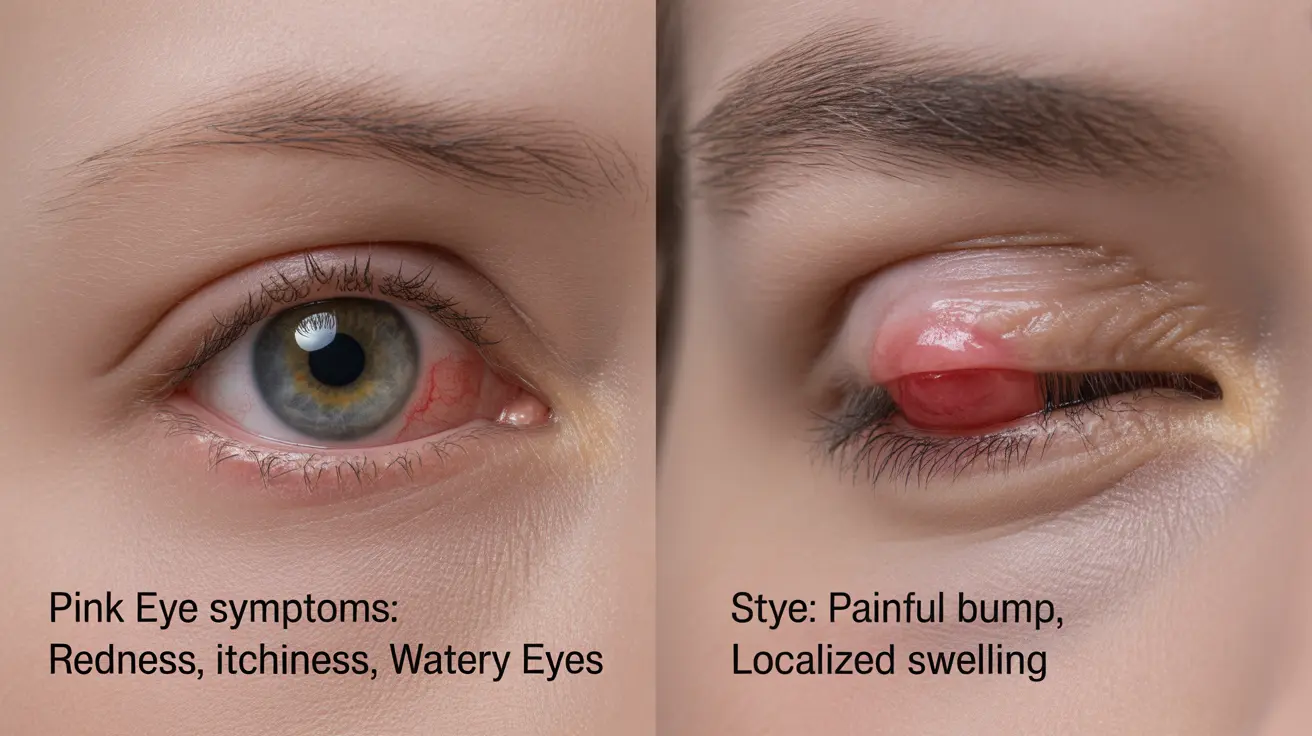When you experience eye discomfort, redness, or swelling, it's crucial to identify whether you're dealing with pink eye (conjunctivitis) or a stye. While both conditions can cause discomfort and affect your eye's appearance, they have distinct characteristics, causes, and treatment approaches. Understanding these differences can help you seek appropriate care and relief more quickly.
Let's explore the key differences between pink eye and styes, including their symptoms, causes, treatments, and when to seek medical attention.
Understanding Pink Eye (Conjunctivitis)
Pink eye, medically known as conjunctivitis, is an inflammation of the conjunctiva - the clear tissue covering the white part of your eye and inner eyelid. This condition can be caused by viral or bacterial infections, allergies, or irritants.
Common Symptoms of Pink Eye
- Redness in the white of the eye
- Watery or mucous discharge
- Itching or burning sensation
- Gritty feeling in the eye
- Sensitivity to light
- Can affect one or both eyes
Types of Pink Eye
Pink eye comes in several forms, each requiring different treatment approaches:
- Viral conjunctivitis (most common)
- Bacterial conjunctivitis
- Allergic conjunctivitis
- Chemical or irritant conjunctivitis
Understanding Styes
A stye is a localized infection that appears as a painful bump on the eyelid. It occurs when an oil gland or eyelash follicle becomes infected with bacteria, typically Staphylococcus aureus.
Characteristics of Styes
- Appears as a red, painful bump on the eyelid
- Usually affects one specific area
- Can form on the outside or inside of the eyelid
- Typically occurs in one eye at a time
- May cause localized swelling and tenderness
Treatment Approaches
Pink Eye Treatment
Treatment for pink eye varies depending on the cause:
- Viral: Usually clears on its own within 1-2 weeks
- Bacterial: Requires antibiotic eye drops
- Allergic: Antihistamine drops or oral medications
- Chemical: Immediate eye flushing and medical attention
Stye Treatment
Most styes can be treated at home with:
- Warm compresses applied 3-4 times daily
- Gentle eyelid cleaning
- Avoiding eye makeup until healed
- Over-the-counter pain relievers if needed
- Medical intervention for persistent cases
Prevention Strategies
Both conditions can often be prevented through good hygiene practices:
- Regular hand washing
- Avoiding touching or rubbing eyes
- Not sharing towels or washcloths
- Removing eye makeup before bed
- Replacing eye makeup regularly
- Maintaining clean contact lenses if worn
Frequently Asked Questions
What are the main differences between pink eye and a stye in terms of symptoms and appearance?
Pink eye typically causes widespread redness across the white of the eye and can affect one or both eyes, while a stye appears as a distinct, painful bump on the eyelid. Pink eye often produces discharge and general eye irritation, whereas a stye causes localized pain and swelling.
How can I tell if my red, swollen eye is caused by pink eye or a stye?
Look at the location and pattern of symptoms. Pink eye causes general redness across the eye surface with possible discharge, while a stye presents as a specific tender bump on the eyelid, similar to a pimple.
What treatments are recommended for pink eye compared to a stye?
Pink eye treatment depends on the cause - viral cases usually resolve naturally, bacterial cases need antibiotics, and allergic cases require antihistamines. Styes typically respond to warm compresses and gentle cleaning, though persistent cases may need medical treatment.
Is pink eye contagious, and can a stye be spread to others?
Viral and bacterial pink eye are highly contagious and can spread through direct contact or contaminated surfaces. Styes themselves aren't typically contagious, but the bacteria that cause them can spread through close contact or shared items.
When should I see a doctor for pink eye or a stye?
Seek medical attention if symptoms persist beyond a week, if you experience severe pain or vision changes, if you have a weakened immune system, or if the condition interferes with daily activities. For pink eye, see a doctor if you have significant discharge or if both eyes are affected.




